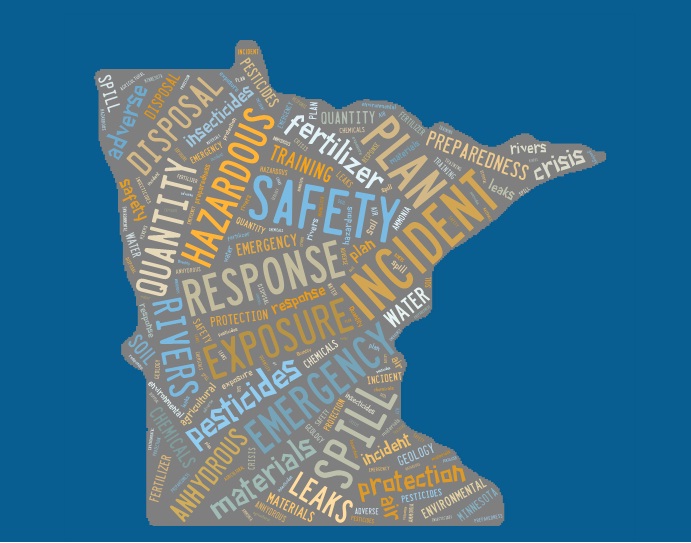 Every year, millions of pounds of agricultural chemicals are safely stored, moved, and used in Minnesota without incident. However, accidents may cause spills and a call to the Duty Officer can connect you to trained emergency responders at the MDA.
Every year, millions of pounds of agricultural chemicals are safely stored, moved, and used in Minnesota without incident. However, accidents may cause spills and a call to the Duty Officer can connect you to trained emergency responders at the MDA.
Start preparing for spills by developing your own incident response plan. There are many actions you can take before, during, and after a spill to reduce environmental damage and also lower your out-of-pocket expenses. Both administrative and engineering controls should be in place to prevent accidents and spills while mixing/loading, rinsing, storing, and disposing of pesticides and fertilizers.
Spills of anhydrous ammonia can be very dangerous and require special handling and equipment. Additional resources and instructions are available for a First Responder's Response.
What is the STARR method for an effective response to a spill?
(Secure, Telephone, Abate, Recover, Remediate)
In an emergency, life-safety is always the first priority. If the incident may cause a threat to public health or safety, phone 911. Make sure no one was hurt or trapped because of the spill, but also clear the area from other employees, onlookers, livestock, and pets. Anyone assisting in the response to a leak or spill must first take steps to protect him/herself by wearing proper personal protective equipment (PPE) and following all safety practices before attempting to stabilize the site.
|
Call to REPORT a pesticide or fertilizer spill day or night 1-800-422-0798 |
For information on spill reporting, see MDA’s Guidance Document 1
Be ready with the following information:
- Substance spilled
- Quantity spilled
- Date and time of spill or when it was discovered
- Location of the spill
- Description of the area; especially drainage, existing surface water, ponded water, ground water table, nearby residences or population centers
- Contact information for who had control of the substance at the time of the spill
- Cause of the spill
Abatement means stopping the release of the pesticide or fertilizer. This may be out of your control, but you might be able to plug a hole in a container, or upright a tipped tank to make sure the remaining chemical stays put. You can also limit how big the spill gets by placing absorbent material on the spill or creating a dike around pooled liquid to stop it from flowing.
Recover spilled material as quickly as possible by pumping up free liquid or sweeping up chemical-soaked absorbent and placing in into a suitable container. Spills that soak into the ground may require excavation. The MDA staff trained in spill clean-up can assist you in determining how deep to dig and whether soil samples will be necessary for lab analysis.
Contaminated soil, absorbent, water, sediment, debris, or other materials are to be stockpiled or disposed of. The preferred method of disposal is by spreading the material on farmland. The MDA staff can calculate spread rates for the particular chemicals that were spilled.

